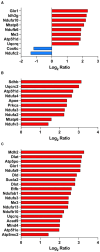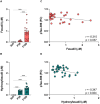Effect of the ROCK inhibitor fasudil on the brain proteomic profile in the tau transgenic mouse model of Alzheimer's disease
- PMID: 38440100
- PMCID: PMC10911083
- DOI: 10.3389/fnagi.2024.1323563
Effect of the ROCK inhibitor fasudil on the brain proteomic profile in the tau transgenic mouse model of Alzheimer's disease
Erratum in
-
Erratum: Effect of the ROCK inhibitor fasudil on the brain proteomic profile in the tau transgenic mouse model of Alzheimer's disease.Front Aging Neurosci. 2024 Apr 10;16:1409164. doi: 10.3389/fnagi.2024.1409164. eCollection 2024. Front Aging Neurosci. 2024. PMID: 38659705 Free PMC article.
Abstract
Introduction: The goal of this study is to explore the pharmacological potential of the amyloid-reducing vasodilator fasudil, a selective Ras homolog (Rho)-associated kinases (ROCK) inhibitor, in the P301S tau transgenic mouse model (Line PS19) of neurodegenerative tauopathy and Alzheimer's disease (AD).
Methods: We used LC-MS/MS, ELISA and bioinformatic approaches to investigate the effect of treatment with fasudil on the brain proteomic profile in PS19 tau transgenic mice. We also explored the efficacy of fasudil in reducing tau phosphorylation, and the potential beneficial and/or toxic effects of its administration in mice.
Results: Proteomic profiling of mice brains exposed to fasudil revealed the activation of the mitochondrial tricarboxylic acid (TCA) cycle and blood-brain barrier (BBB) gap junction metabolic pathways. We also observed a significant negative correlation between the brain levels of phosphorylated tau (pTau) at residue 396 and both fasudil and its metabolite hydroxyfasudil.
Conclusions: Our results provide evidence on the activation of proteins and pathways related to mitochondria and BBB functions by fasudil treatment and support its further development and therapeutic potential for AD.
Keywords: Alzheimer's disease; P301S; PS19; fasudil; proteomic; tau.
Copyright © 2024 Collu, Yin, Giunti, Daley, Chen, Morin, Killick, Wong and Xia.
Conflict of interest statement
WX received funding (2020-2023) from Eisai, Inc. The remaining authors declare that the research was conducted in the absence of any commercial or financial relationships that could be construed as a potential conflict of interest.
Figures






Similar articles
-
Erratum: Effect of the ROCK inhibitor fasudil on the brain proteomic profile in the tau transgenic mouse model of Alzheimer's disease.Front Aging Neurosci. 2024 Apr 10;16:1409164. doi: 10.3389/fnagi.2024.1409164. eCollection 2024. Front Aging Neurosci. 2024. PMID: 38659705 Free PMC article.
-
Reduction of Phosphorylated Tau in Alzheimer's Disease Induced Pluripotent Stem Cell-Derived Neuro-Spheroids by Rho-Associated Coiled-Coil Kinase Inhibitor Fasudil.J Alzheimers Dis. 2023;96(4):1695-1709. doi: 10.3233/JAD-230551. J Alzheimers Dis. 2023. PMID: 38007655
-
Biologic TNF-α inhibitors reduce microgliosis, neuronal loss, and tau phosphorylation in a transgenic mouse model of tauopathy.J Neuroinflammation. 2021 Dec 31;18(1):312. doi: 10.1186/s12974-021-02332-7. J Neuroinflammation. 2021. PMID: 34972522 Free PMC article.
-
Rock inhibitors in Alzheimer's disease.Front Aging. 2025 Mar 20;6:1547883. doi: 10.3389/fragi.2025.1547883. eCollection 2025. Front Aging. 2025. PMID: 40182055 Free PMC article. Review.
-
Advantages of Rho-associated kinases and their inhibitor fasudil for the treatment of neurodegenerative diseases.Neural Regen Res. 2022 Dec;17(12):2623-2631. doi: 10.4103/1673-5374.335827. Neural Regen Res. 2022. PMID: 35662192 Free PMC article. Review.
Cited by
-
Clearing Amyloid-Beta by Astrocytes: The Role of Rho GTPases Signaling Pathways as Potential Therapeutic Targets.Brain Sci. 2024 Dec 10;14(12):1239. doi: 10.3390/brainsci14121239. Brain Sci. 2024. PMID: 39766438 Free PMC article. Review.
-
ROCK Inhibitor Fasudil Attenuates Neuroinflammation and Associated Metabolic Dysregulation in the Tau Transgenic Mouse Model of Alzheimer's Disease.Curr Alzheimer Res. 2024;21(3):183-200. doi: 10.2174/0115672050317608240531130204. Curr Alzheimer Res. 2024. PMID: 38910422 Free PMC article.
-
Protective Effects of Fasudil Against Cisplatin-Induced Ototoxicity in Zebrafish: An In Vivo Study.Int J Mol Sci. 2024 Dec 13;25(24):13363. doi: 10.3390/ijms252413363. Int J Mol Sci. 2024. PMID: 39769128 Free PMC article.
-
Fasudil Alleviates Postoperative Neurocognitive Disorders in Mice by Downregulating the Surface Expression of α5GABAAR in Hippocampus.CNS Neurosci Ther. 2024 Nov;30(11):e70098. doi: 10.1111/cns.70098. CNS Neurosci Ther. 2024. PMID: 39491498 Free PMC article.
-
Role of Rho-associated kinases and their inhibitor fasudil in neurodegenerative diseases.Front Neurosci. 2024 Nov 19;18:1481983. doi: 10.3389/fnins.2024.1481983. eCollection 2024. Front Neurosci. 2024. PMID: 39628659 Free PMC article. Review.
References
-
- Ahmed L. A., Darwish H. A., Abdelsalam R. M., Amin H. A. (2016). Role of rho kinase inhibition in the protective effect of fasudil and simvastatin against 3-nitropropionic acid-induced striatal neurodegeneration and mitochondrial dysfunction in rats. Mol. Neurobiol. 53, 3927–3938. 10.1007/s12035-015-9303-2 - DOI - PubMed
Grants and funding
LinkOut - more resources
Full Text Sources
Molecular Biology Databases
Miscellaneous

